Tender tofu cooked in an umami and spicy sauce, accompanied by minced meat, Mapo tofu is one of the tastiest ways to prepare this healthy ingredient.
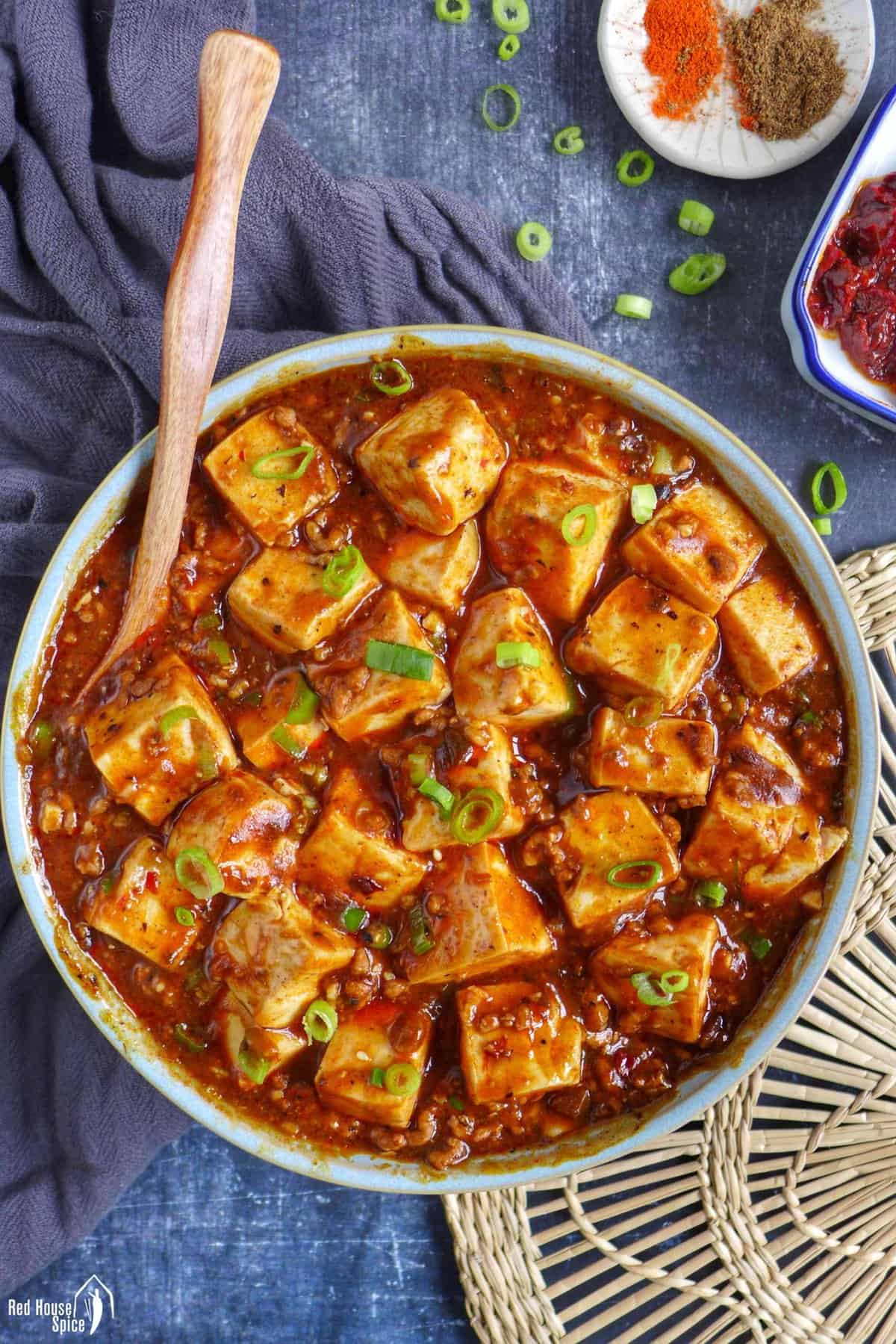
Note: This is a revised version of my post on Mapo tofu. It includes more tips, substitute ideas and FAQs. New images and a video are also included.
“What is your favourite tofu dish?” Once I asked a group of non-Chinese friends who had experiences with Chinese food. Their answer “Mapo tofu” didn’t surprise me. Today, I’d like to show you how to cook this classic dish the authentic way (with the formula I learned from a chef in Sichuan).
Jump to:
Why is it call Mapo tofu?
A signature dish of Sichuan cuisine, Mapo tofu (麻婆豆腐) is believed to be named after its inventor “Mapo/麻婆” who ran a small restaurant over a century ago in Chengdu, the capital of Sichuan province.
“Mapo” isn’t the name but a description of this originator. It literally means an elderly lady with a pockmarked face.
The classic version of Mapo tofu contains tender tofu cubes and minced meat coated with an aromatic, hot and mouth-tingling sauce made with a set of quintessential condiments and spices of Sichuan cooking.
As Mapo tofu became popular outside China, it is often presented in restaurants with various adaptations. Some of these alterations are modest while the others are quite dramatic. Today’s Mapo tofu recipe reflects the way this dish is traditionally prepared in terms of the flavour, spice level and texture.
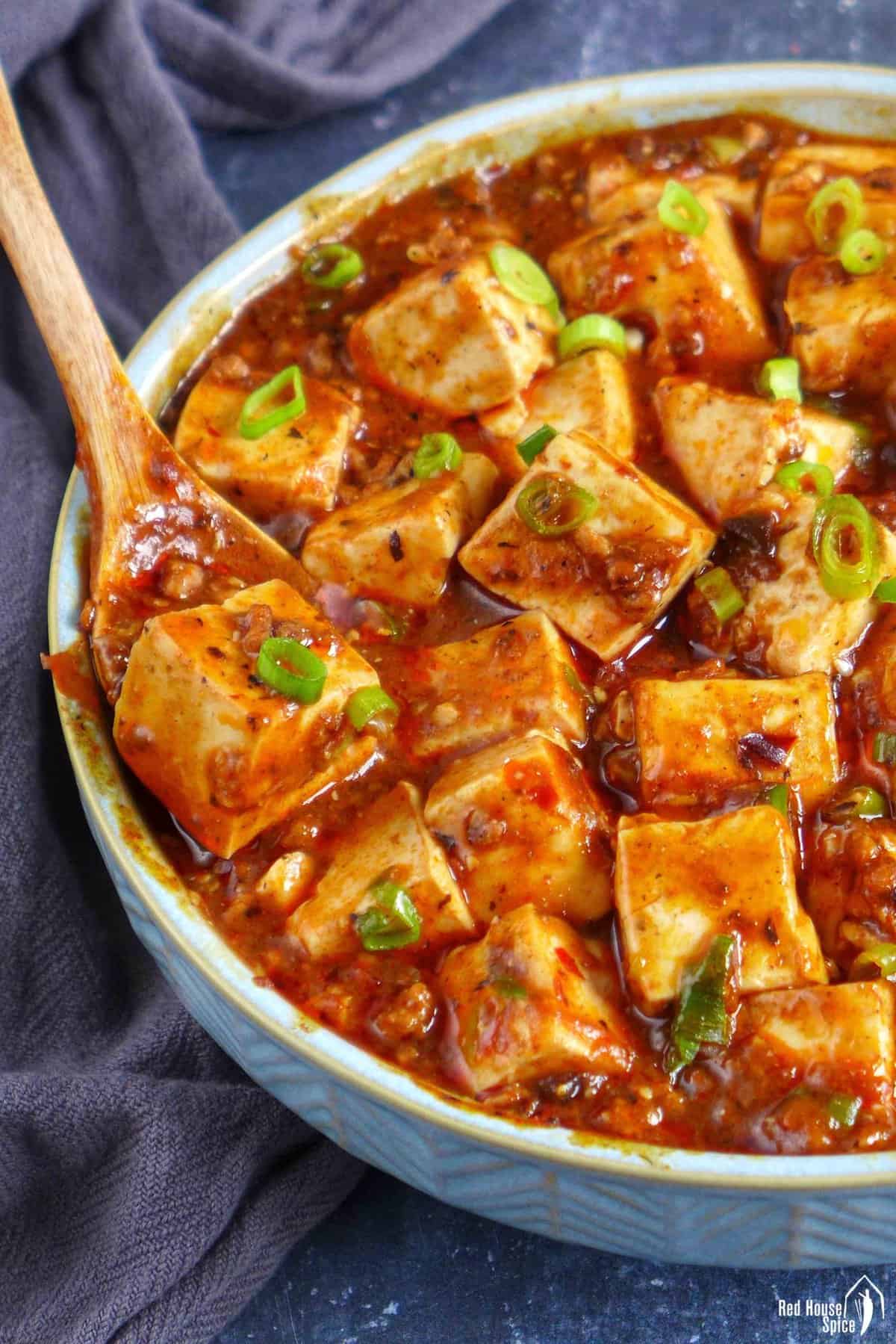
What does it taste like
If you think tofu dishes are bland, then you need to try this dish. Sichuan chefs use five words to label the taste of top-notch Mapo tofu: spicy, mouth-numbing, aromatic, tender and hot.
- Spicy (辣): Both Sichuan chilli bean paste (aka spicy Doubanjiang) and chilli powder/flakes contribute to the spiciness. The latter also enhances the red colour of the dish.
- Mouth-Numbing (麻): This particular sensation comes from Sichuan pepper, a spice unique to Chinese cuisine.
- Aromatic (香): The aroma comes from fermented black beans, aromatics (ginger and garlic), minced meat, as well as the sauce and spices mentioned above.
- Tender (嫩): This refers to the texture of the tofu. It should be jiggly and soft but doesn’t fall apart easily (more on tofu choices in later sections).
- Hot, physically (烫): For best taste, it needs to be served right after cooking when the flavour of the dish is at its peak (but be careful not to burn your mouth as tofu holds heat very well).
Ingredients
Here is a list of ingredients you need to make classic Mapo tofu (more info on key ingredients and quantity in later sections):

- Tofu (soft or medium-firm)
- Minced beef/pork (or shiitake mushrooms for a vegan diet)
- Sichuan chilli bean paste
- Fermented black beans
- Chilli powder/flakes
- Ground Sichuan pepper
- Ginger, garlic, scallions
- Shaoxing rice wine
- Cornstarch
You should be able to find the sauces and spices above in your local Chinese/Asian supermarkets or popular online shopping platforms.
What type of tofu
Mapo tofu calls for regular tofu (aka block tofu) which is pressed into large blocks then cut into pieces for sale. It’s often soaked in water and has a coarse or fine sponge texture.
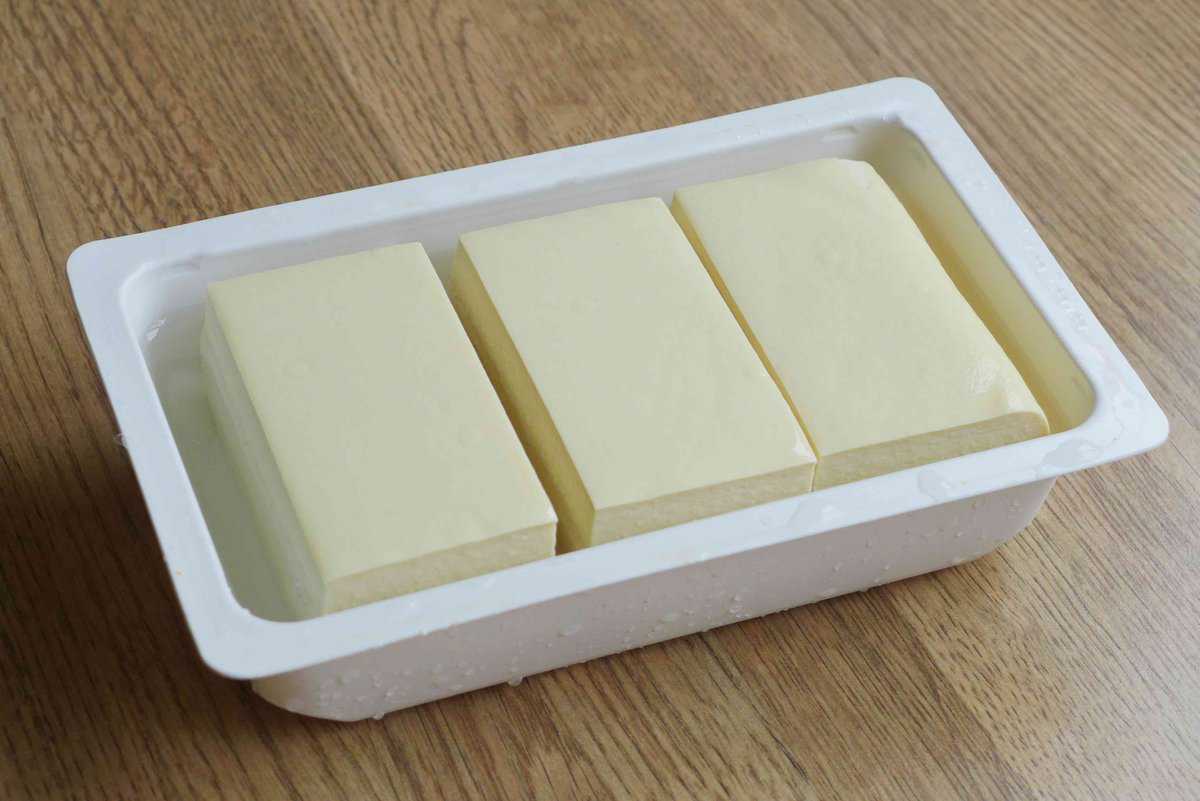
Two types of regular tofu are commonly used in traditional Chinese cuisine: Soft tofu (Nen Dou Fu/嫩豆腐) and firm tofu (Lao Dou Fu/老豆腐 or Bei Dou Fu/北豆腐).
Soft regular tofu is the perfect choice for Mapo tofu thanks to its tender, jiggly and slippery texture. Although much softer than firm tofu, it doesn’t break easily if handled and cooked properly (see tips in the cooking sections below).
🛎 TIP: I’ve seen soft tofu (嫩豆腐) sold in Chinese supermarkets labelled as “Medium-firm”. If unsure, ask shop assistants for help (show them the Chinese characters above).
Although not the popular choice, firm regular tofu is also acceptable for this dish as some people prefer its pronounced “bean flavour” and its ability to soak up seasonings.
🛎 NOTE: Silken tofu (绢豆腐), a type of unpressed tofu that coagulates directly in its container, isn’t traditionally used for Mapo tofu. But it’s acceptable as a substitute. In this case, choose medium-firm or firm silken tofu and avoid the soft version.
Minced meat and its substitute
In Chinese cooking, tofu dishes often contain a small amount of meat for extra flavour (Think Hakka-Style Stuffed Tofu). Minced beef or pork is commonly used in Mapo tofu. Replace it with chicken or turkey if you wish.
🥬 Vegan Mapo tofu: Shiitake mushrooms can be used as a substitute for the vegan version. Dried ones are preferable to fresh ones as they have a more complex flavour. Soak until plump. Trim off the stems then chop into small pieces.
Sichuan chilli bean paste
Considered the soul of Sichuan cuisine, chilli bean paste (aka spicy doubanjiang) is indispensable for making authentic Mapo tofu. It’s a fermented sauce made of broad beans and chilli peppers. Read my chilli bean paste post to learn all you need to know about this unique ingredient.
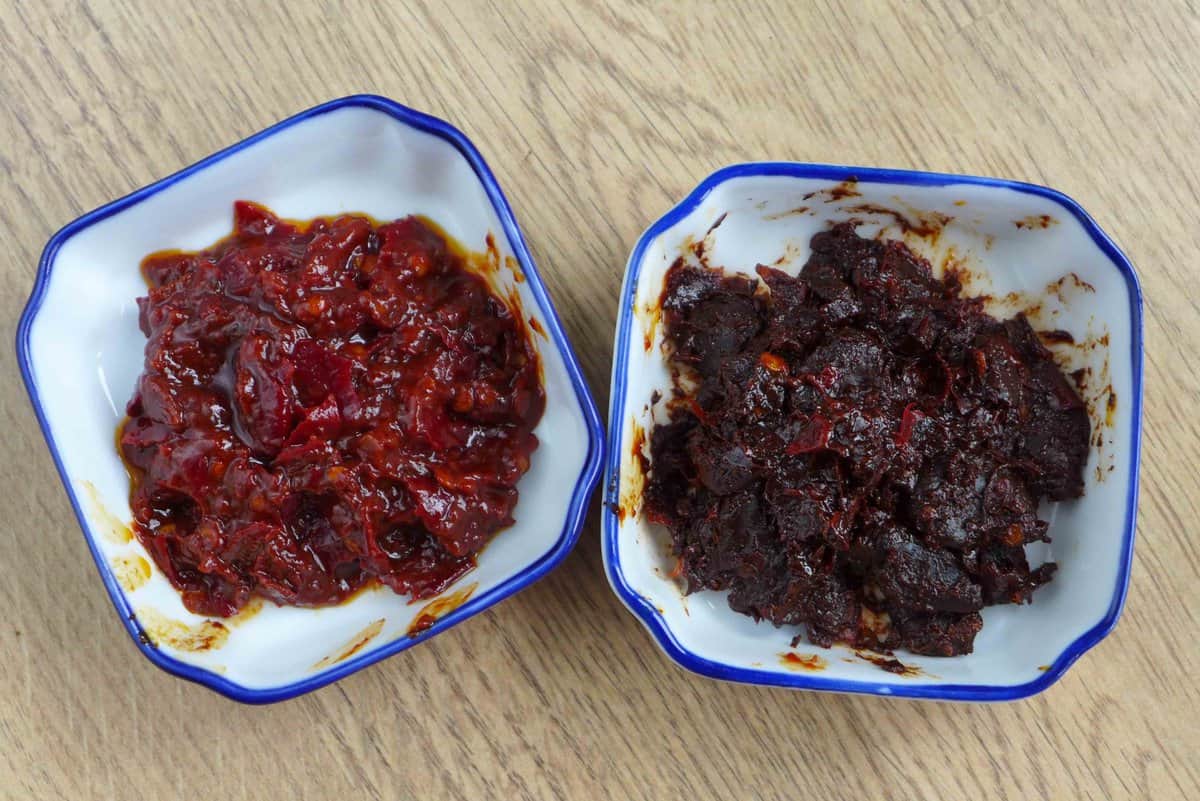
When sourcing it in Chinese/Asian markets, look for its best variety Pixian Douban (郫县豆瓣) which comes in two versions: the regular (right in the image above) and the red oil version (left in the image above). Both are great for today’s dish.
🛎 TIP: If using the regular version, remember to chop it finer beforehand for a better mouthfeel.
Ground chilli or chilli flakes
Dried chilli pepper, in the form of either powder or flakes, provides spiciness and an appetising red colour to the dish. Please feel free to use any type available that suits your tolerance to heat. Ideally, it shouldn’t contain other spices or salt.
Sichuan pepper
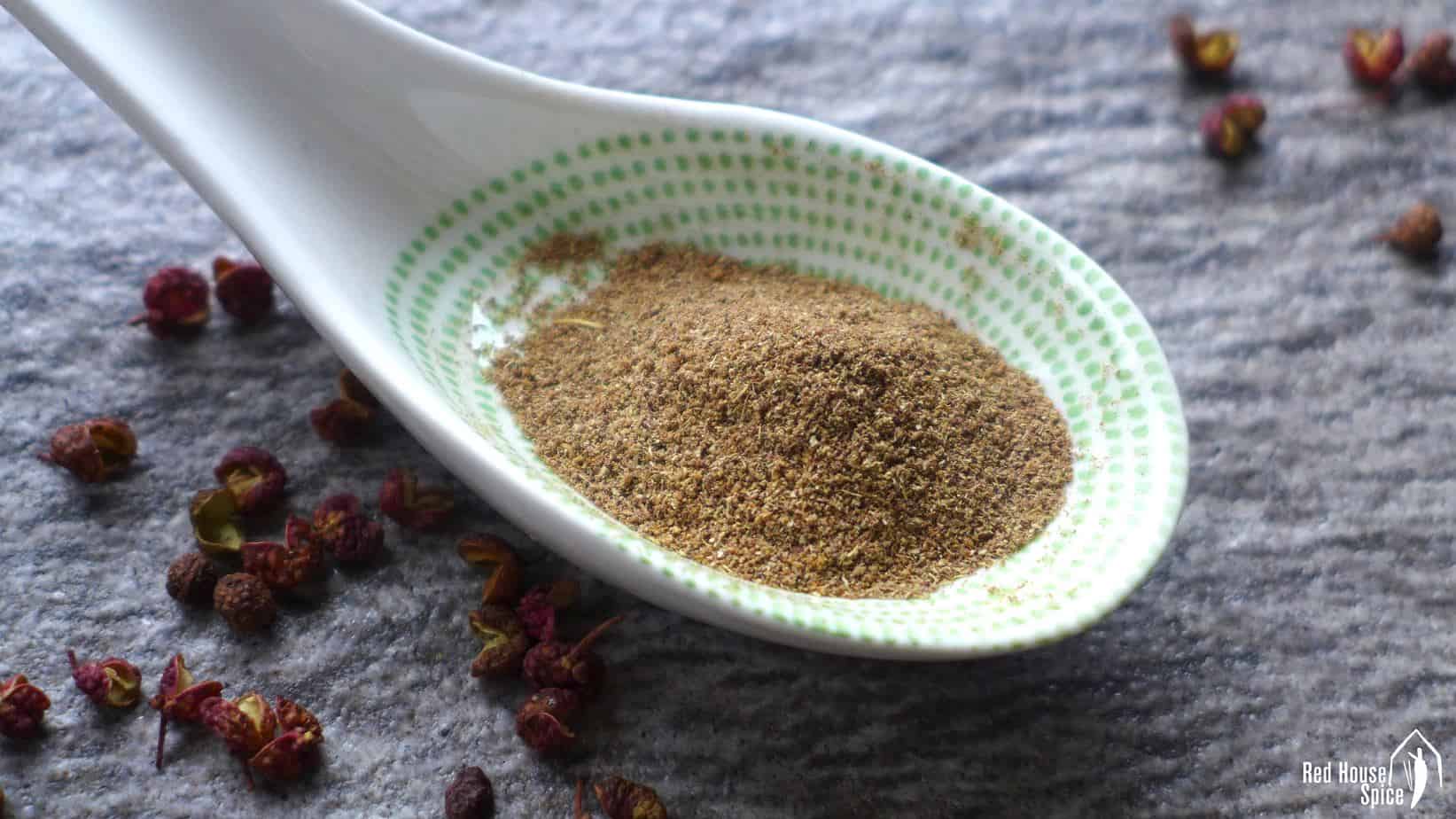
An essential flavour component of Mapo tofu, Sichuan pepper is also a must-have ingredient (unfamiliar with this unique spice? Read my Complete Guide to Sichuan Peppercorns). It’s typically paired with chillies to create the iconic flavour profile known as Mala/麻辣, meaning mouth-numbing and spicy.
When time permits, I use freshly ground Sichuan pepper that only takes a few simple steps to make. Ready-to-use ones found in Chinese/Asian shops are also fine.
Fermented black beans
A typical flavour source in Mapo tofu, fermented black beans (Dou Chi/豆豉) often pairs with chilli bean paste in Sichuan dishes (such as Black Bean Sauce, Twice-cooked Pork). They deliver a complex taste: fragrant, earthy, salty and bittersweet.
Although important, it can be omitted, in my opinion, as the taste of the dish won’t be greatly compromised without them.
Cooking procedure
It only takes a few simple steps to cook Mapo tofu: blanch tofu cubes in salted water; fry minced meat with aromatic seasonings; braise tofu in the flavoured broth which is thickened at the end.
Step 1: Blanch
This step is to help firm up the tofu cubes so that they don’t break while handling but retain the bouncy, tender texture.
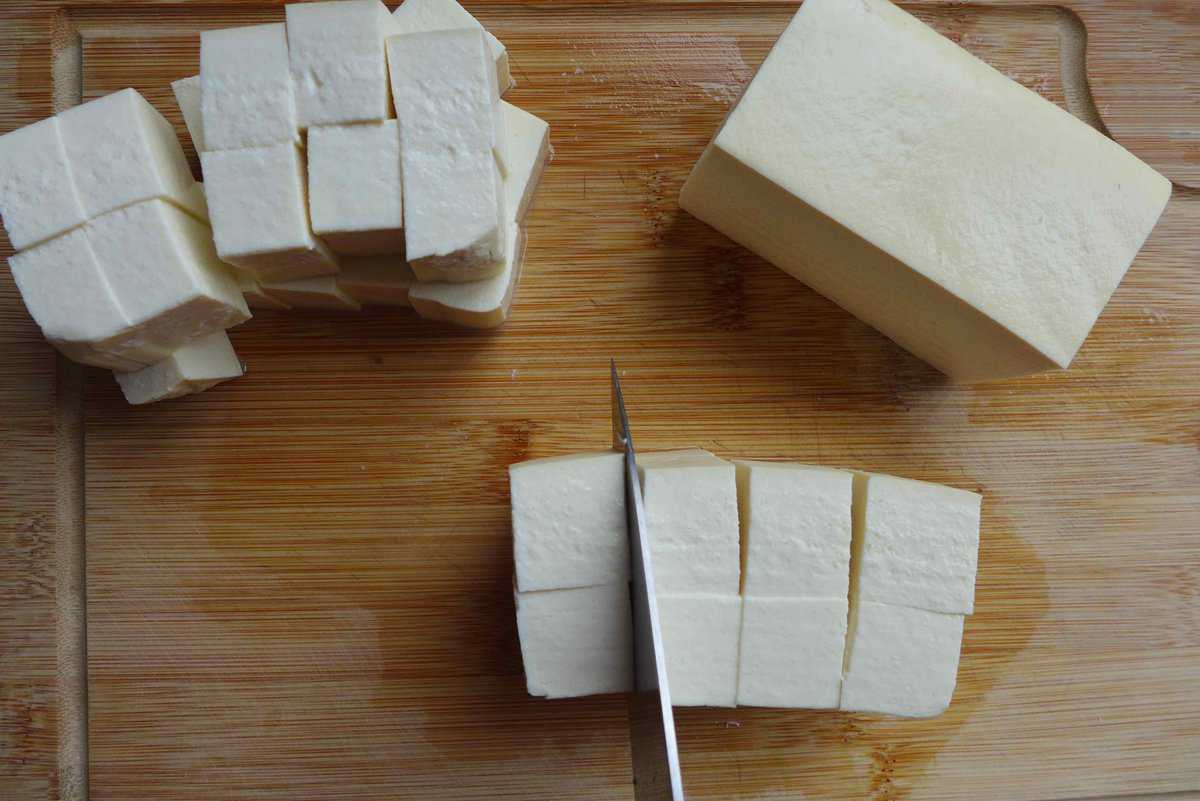
After cutting the tofu into cubes (about 2.5cm/1inch), gently slide them into a wok/pot filled with cold water. Add 1 teaspoon of salt.
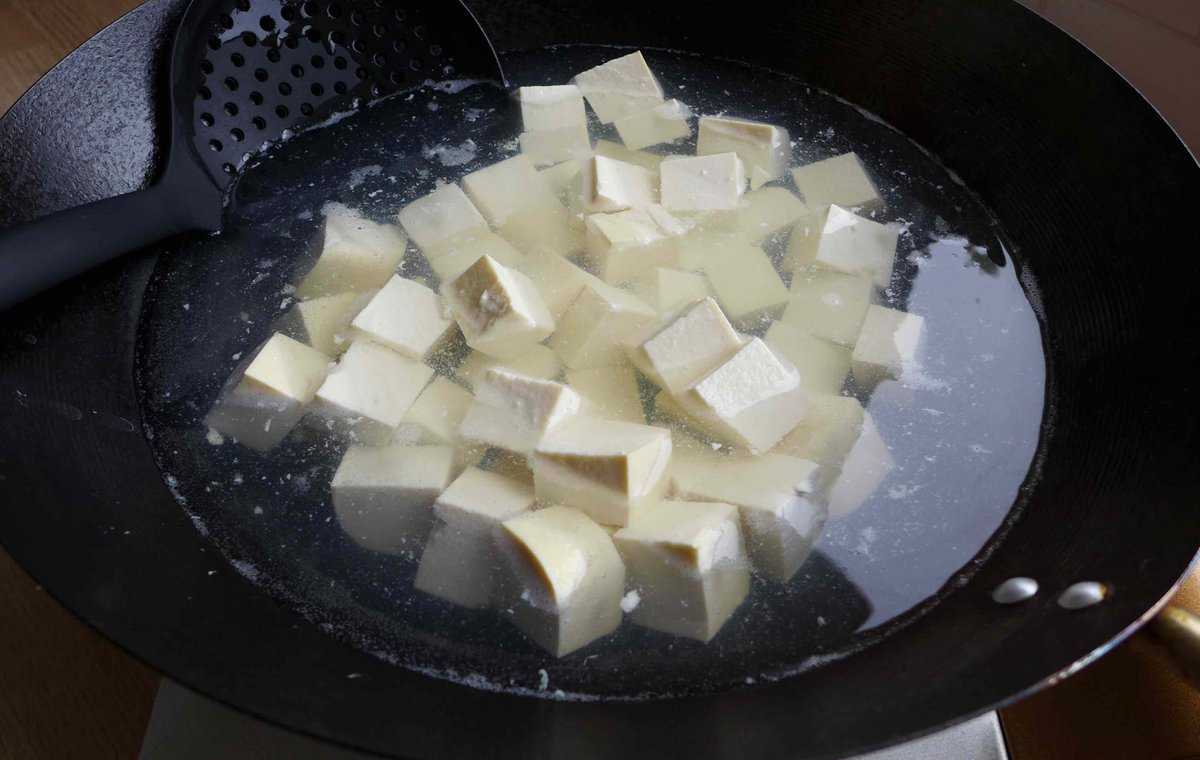
Over high heat, bring the water to a gentle boil. Then turn down the heat to let it simmer for 1 minute. Fish out the tofu and set it aside.
Step 2: Fry
During this step, you’re going to combine all the flavour components of the dish.
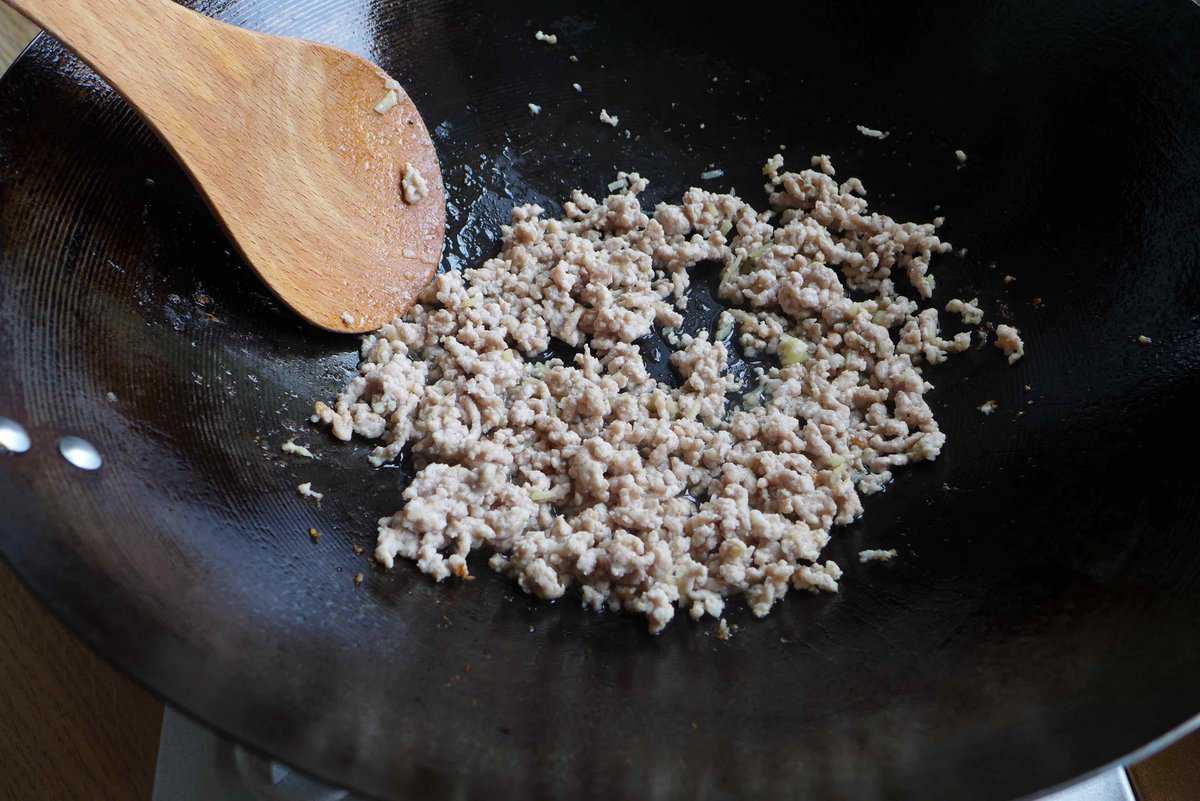
Heat up a clean, empty wok until hot then add the oil (if using non-stick cookware, add the oil first then heat). Put in the minced meat and minced ginger. Stir-fry over high heat until the meat loosens and becomes pale.
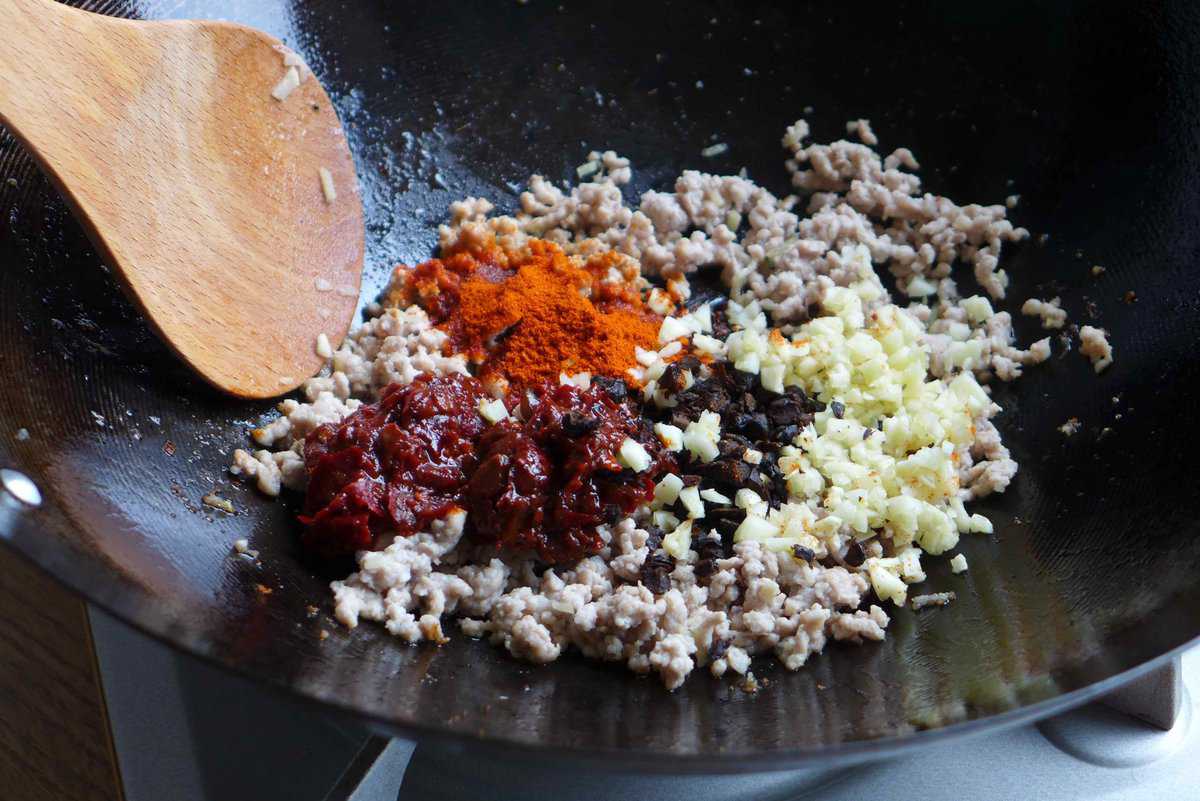
Add Sichuan chilli bean paste, fermented black beans, chilli powder/flakes and minced garlic. Fry until well combined and the aroma intensifies in the air.
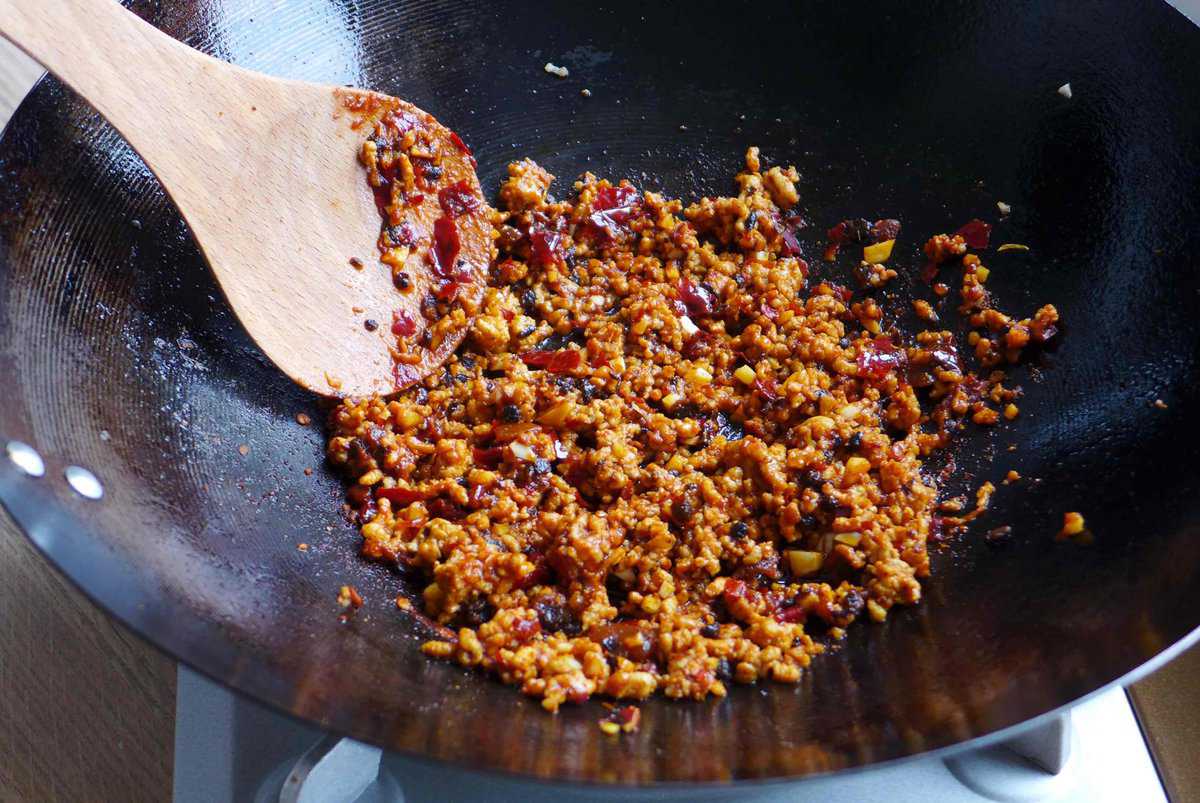
Step 3: Braise
This step allows the tofu to absorb the fragrant cooking liquid which is thickened towards the end.
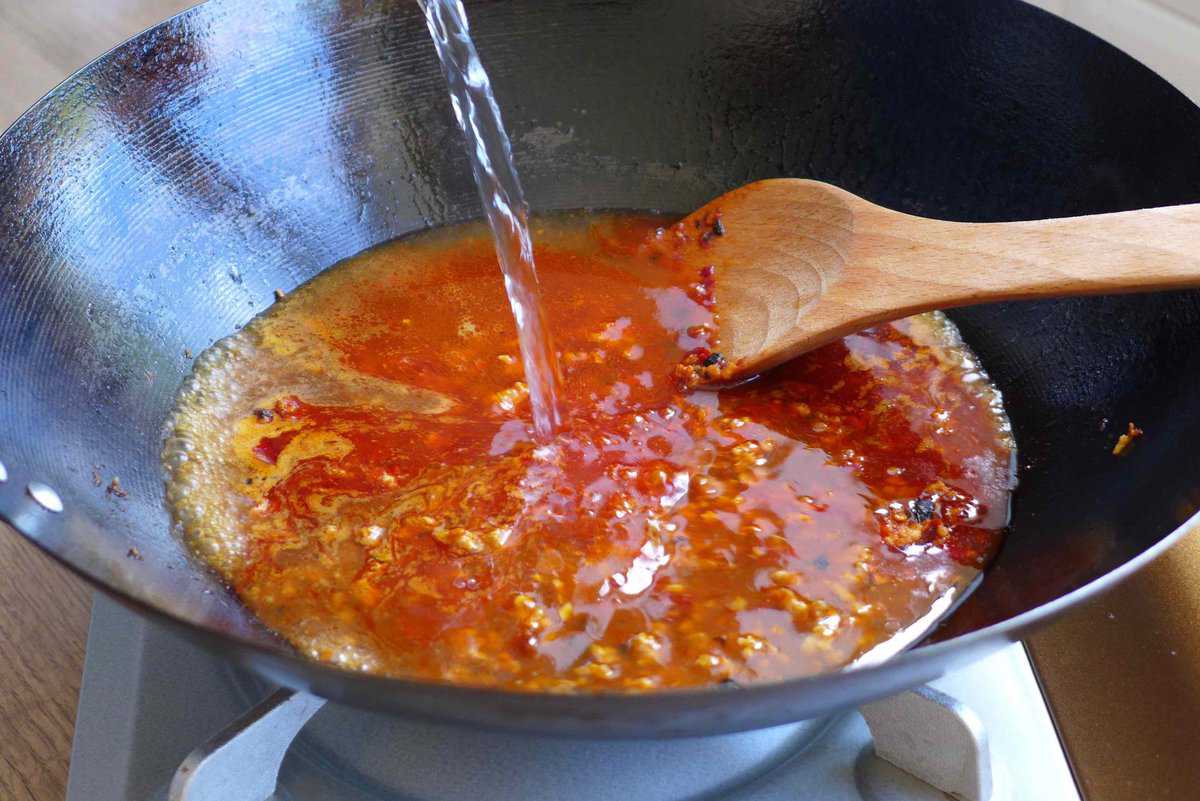
Pour in Shaoxing rice wine and water (you may use unsalted chicken stock for a richer taste). Bring to a boil then gently slide in the drained tofu. Leave to boil over high heat for about 5 minutes (uncovered).
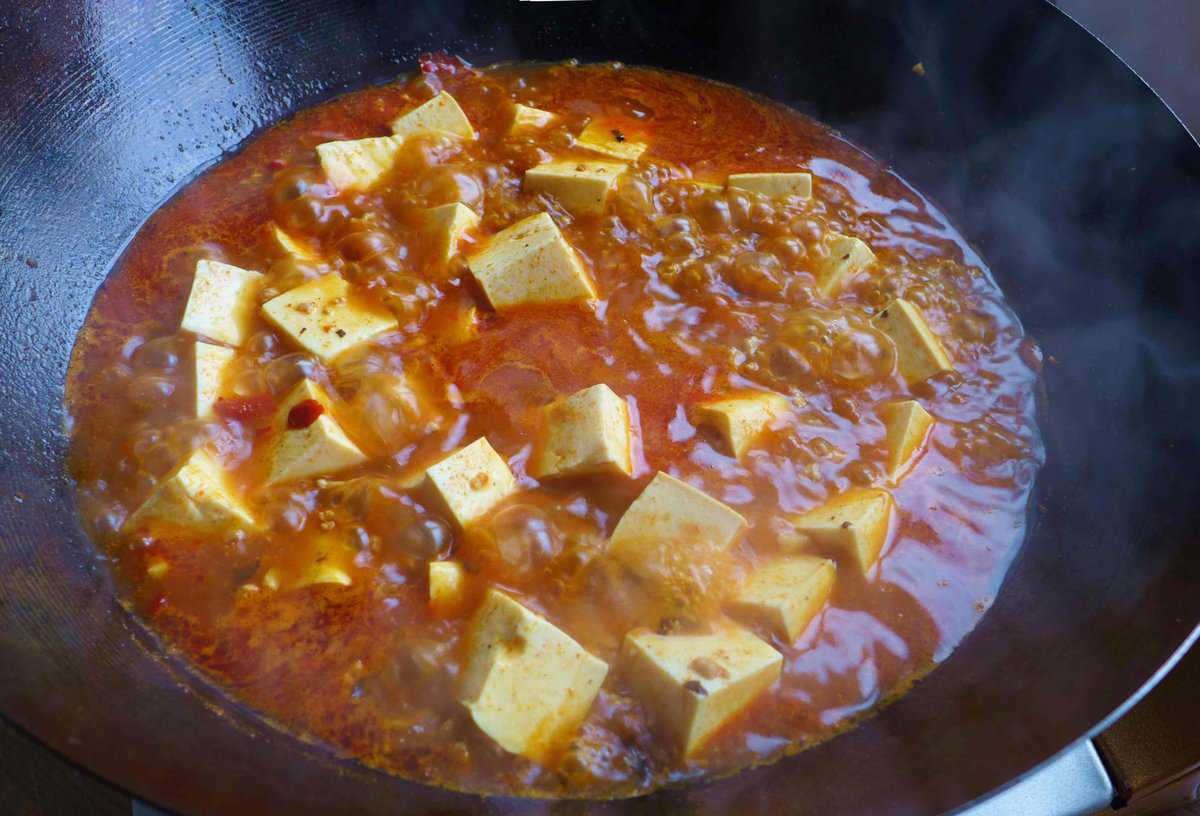
While waiting, mix some cornstarch with cold water in a small bowl. When time is up, lower the heat to medium. Pour in half of the mixture (make sure to stir it well beforehand). Leave to simmer for 10 seconds or so, then pour in the other half.
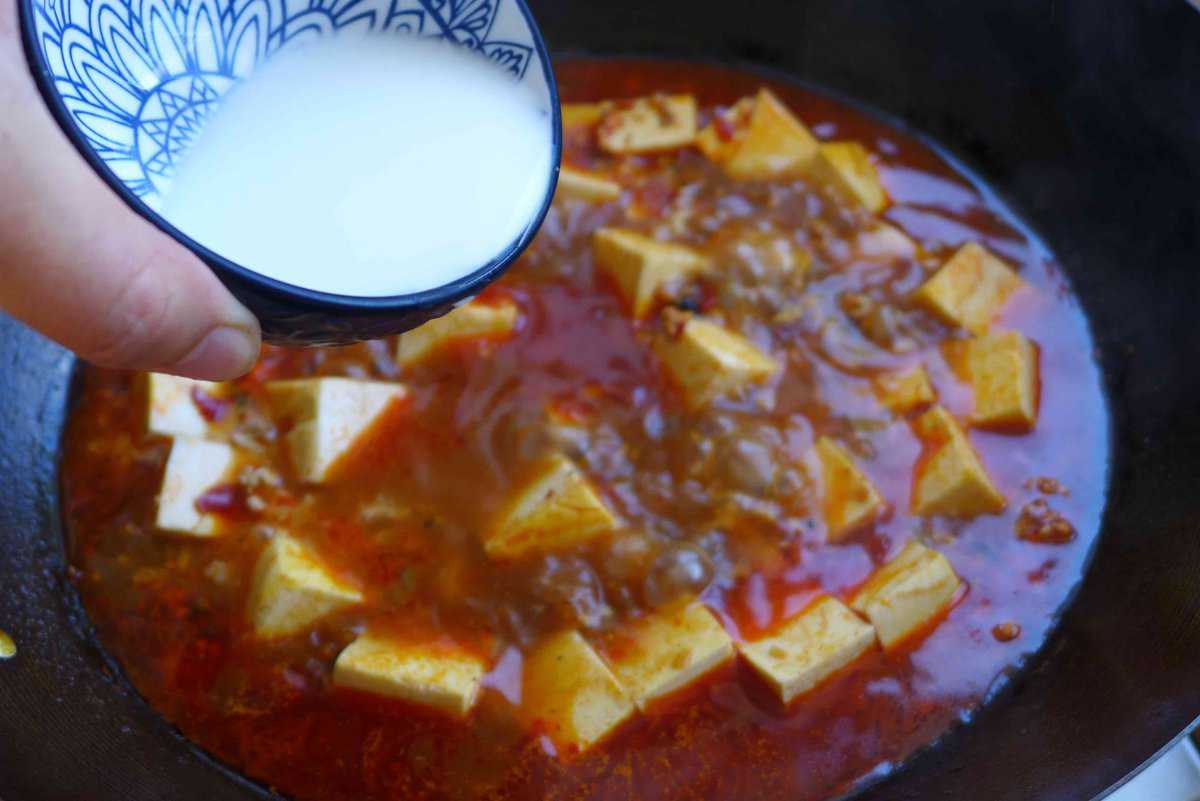
Gently stir to evenly distribute the thickening agent. Once the sauce becomes just thick enough to coat your spatula, add ground Sichuan pepper and sprinkle chopped scallions over. Give everything a final mix and remove from the heat immediately.
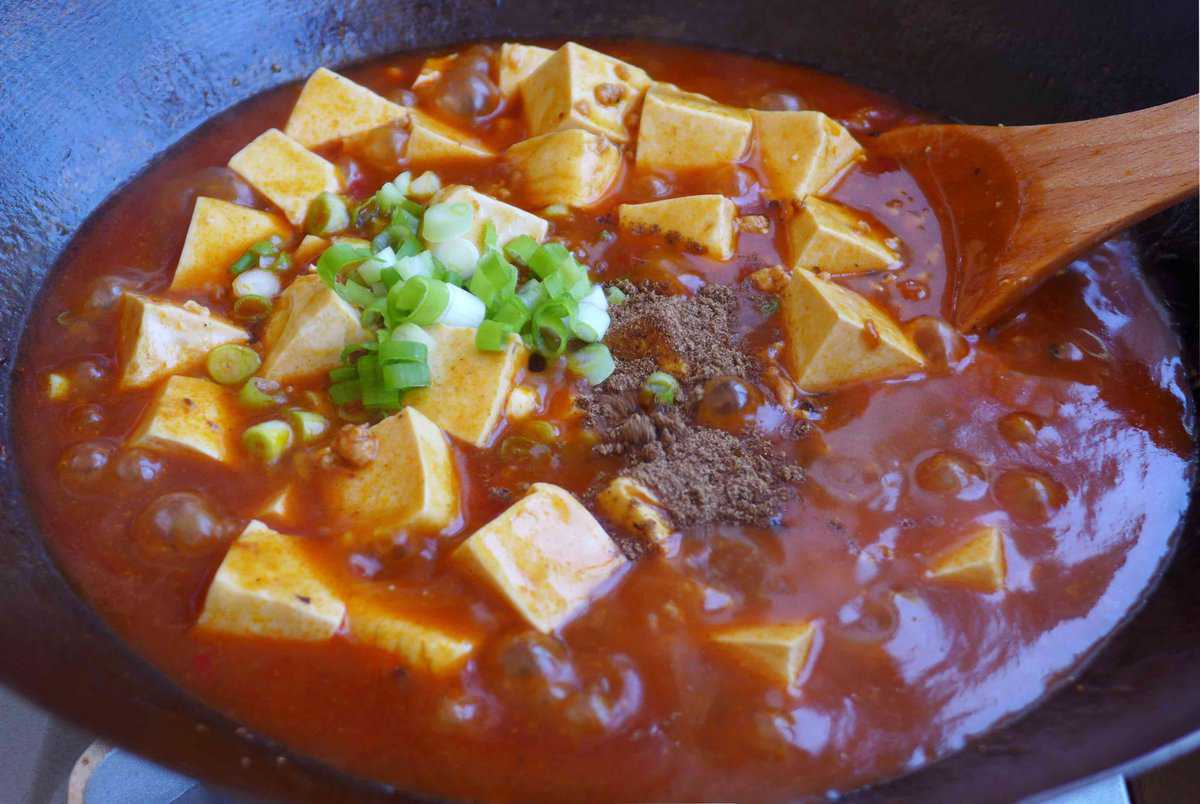
🛎 TIPS:
- Sauce thickening: After pouring in the cornstarch slurry, the cooking liquid will thicken pretty quickly. When it looks a little runnier than your desired consistency, you should stop cooking as it will become thicker by the time the dish is served at the table. Don’t overcook. Otherwise, the sauce will turn lumpy.
- Use round-edged utensils to handle the tofu in case you accidentally break it.
What to serve with
For a quick lunch, simply pour it over plain steamed rice. Although not a common option, I also like serving it with noodles (love how the sauce clings onto the noodle strands).
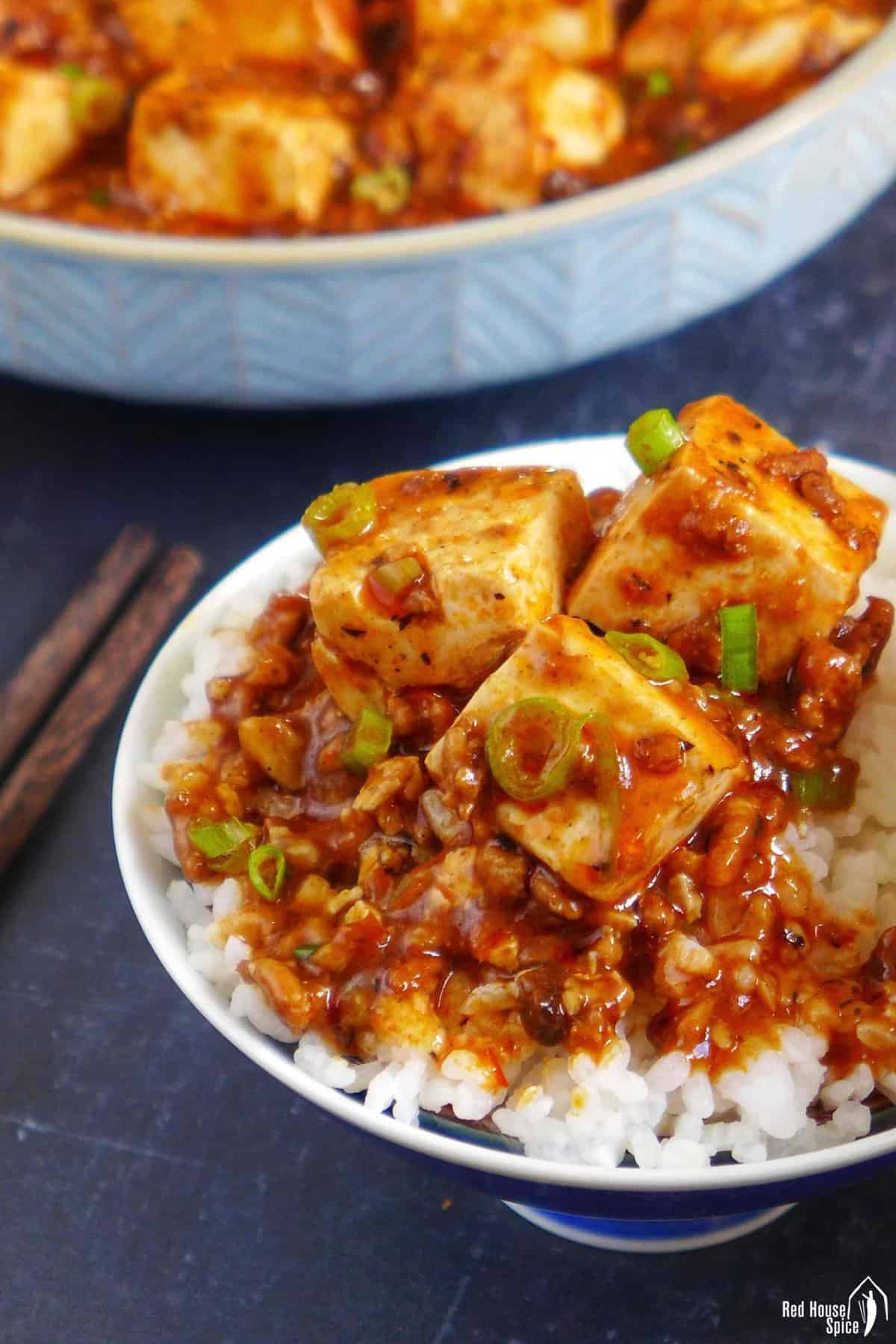
Or, include it in a multi-dish dinner. Pair it with other savoury protein or vegetable dishes. Take what we had last Saturday for example: Mapo tofu, steamed chicken, smashed cucumber, hot and sour soup and jasmine rice. Does this combination sound good?
FAQs
A: There isn’t a substitute but you can use the following ideas to create a nice-tasting dish (despite not being authentic).
a) Use homemade spicy black bean sauce, or commercial ones like Laoganma black bean chilli sauce (老干妈风味豆豉). In this case, you can omit fermented black beans in the recipe.
b) Mix an Asian fermented bean paste (e.g. Chinese yellow bean sauce, Japanese miso, Korean doenjang) with Chinese chilli oil or a hot sauce of your choice.
N.B. You may need to adjust the quantity based on the saltiness of individual condiments.
A: As I explained in my Sichuan Pepper Guide, there isn’t another spice that tastes similar. It is a key ingredient for the classic version of Mapo tofu. However, adding a little black pepper wouldn’t ruin the dish with the presence of other key seasonings.
A: Please feel free to reduce the quantity of ground chilli/chilli flakes. Or, choose a variety that looks vibrantly red but doesn’t taste hot (e.g. paprika). Sichuan chilli bean paste has medium heat so use a little less if you wish (add a little soy sauce to make up the saltiness). Another way is to add some sugar to neutralise the hotness.
A: You surely can! I’ve used the same set of seasonings and methods to cook diced chicken thighs and vegetables such as aubergines, king oyster mushrooms, cauliflowers, etc.
Other tofu dishes
As a very healthy source of protein, tofu can be prepared in so many scrumptious ways: in salads, stir-fries, stews, soups, etc. Here are some classics to try:
📋 Recipe
Love this recipe? Please leave a 5-star 🌟🌟🌟🌟🌟 rating in the recipe card below & if you REALLY like it, consider leaving a comment as well!
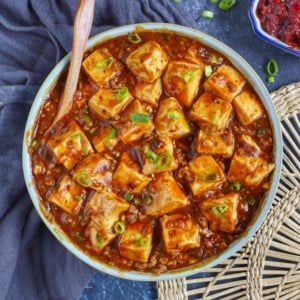
Mapo Tofu, the Authentic Way (麻婆豆腐)
Ingredients
For the tofu
- 600 g regular tofu - soft or medium firm (see note 1)
- 1 teaspoon salt
For the sauce
- 2 tablespoon neutral cooking oil
- 100 g minced beef - or pork
- 1 teaspoon minced ginger
- 2 tablespoon Sichuan chilli bean paste - see note 2
- 1 tablespoon fermented black beans - rinsed and chopped
- 1 tablespoon ground chilli - or chilli flakes (or to taste)
- 1 tablespoon minced garlic
- 1 tablespoon Shaoxing rice wine
- 400 ml water - or unsalted stock
- 2 tablespoon cornstarch - mixed with 3 tablespoons water
You also need
- ½ teaspoon ground Sichuan pepper - or to taste
- 1 stalk scallions - finely chopped
Instructions
Blanch
- Cut the tofu into 2.5cm/1inch cubes. Gently slide them into a wok/pot filled with water. Add the salt. Bring the water to a boil then simmer for 1 minute. Drain the tofu and set it aside.
Fry
- Heat up an empty wok until hot then add the oil. Put in minced meat, along with minced ginger. Stir fry over high heat until the meat becomes pale.
- Add Sichuan chilli bean paste, fermented black beans, chilli powder/flakes and minced garlic. Fry until fragrant.
Braise
- Pour in Shaoxing rice wine and 400ml of water or unsalted stock. Bring to a boil then gently slide in the tofu. Leave to boil for about 5 minutes (uncovered).
- Turn the heat down to medium. Add half of the cornstarch water mixture (make sure to stir it well beforehand). Leave to simmer for 10 seconds or so, then pour in the remaining half.
- Once the sauce becomes just thick enough to coat the spatula, add ground Sichuan pepper and chopped scallions. Give everything a gentle mix then turn off the heat immediately. Serve it hot with plain steamed rice.
Video
NOTES
NUTRITION
NUTRITION DISCLOSURE: Nutritional information on this website is provided as a courtesy to readers. It should be considered estimates. Please use your own brand nutritional values or your preferred nutrition calculator to double check against our estimates.



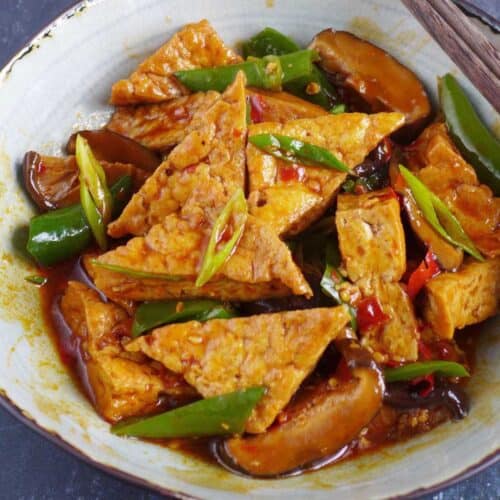
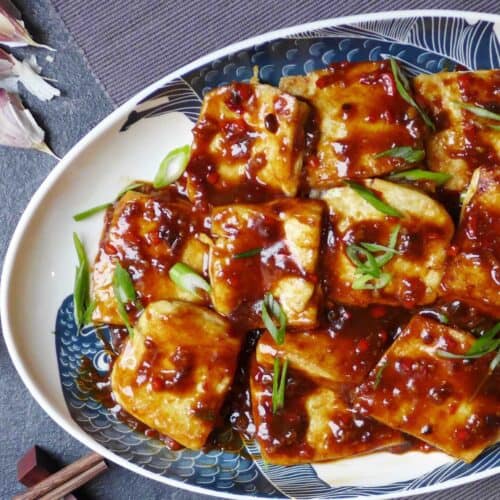
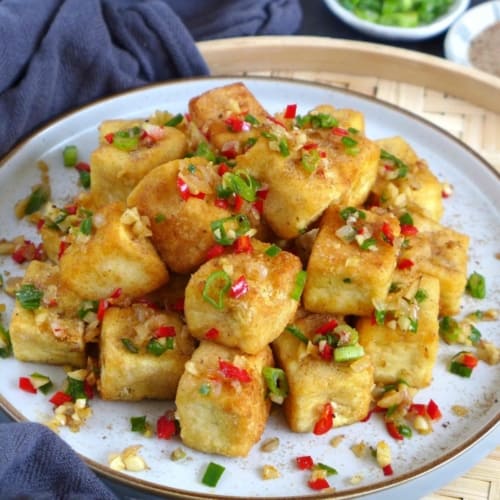
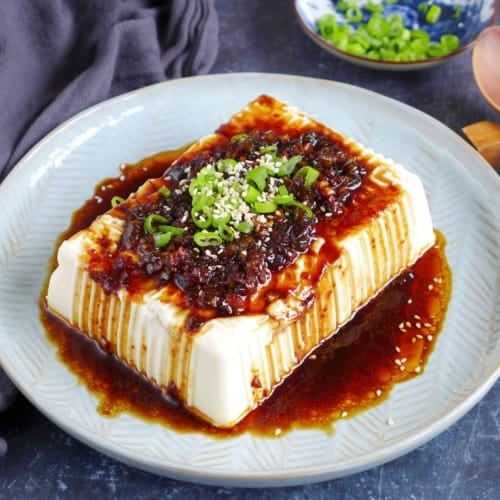
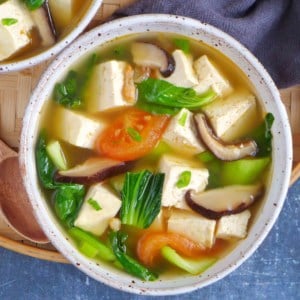
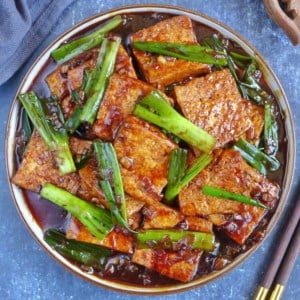

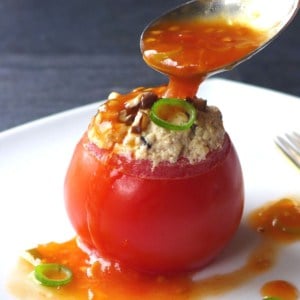
I love Mapo Tofu and I love your recipes, although I have never tried youe version. All the recipes I know are made with black Chinkiang vinegar. Is that not authentic?
Love
Bine
I’ve never had any Mapo tofu dishes or come across any recipes that use Chinkiang vinegar. This dish is not supposed to have an acidic flavour.
I’ve cooked this dish many times now and it has become a family favorite. I reserve the pork on the side as my wife is a vegetarian and I’ve tried several different chili powders from good ol’ cayenne to gochu garu. But you definitely need the sichuan bean paste. I tried using Korean gochujang and while it is a satisfying heat, it is different from the pepper cultivar used in the sichuan paste. Anyway, thanks, once again, for this recipe. It’s a great, year round dish IMO.
You’re welcome David! Very happy to hear your positive feedback.
Hi David.
Fellow vegetarian. I use Quorn frozen mince instead. Works very well.
Thanks for the tip, Fintan, only I live in semi-rural Texas, so I’ve never seen Quorn products. I could probably find it at a Whole Foods in Dallas. There is a soy chorizo available that I’m thinking about using though.
Greetings Wei
I cooked Mapo Tofu and served it over Jasmine rice last night.. It was superb! I definitely scaled back on the chilli flakes/ground chilli to drop the “burn factor”! Nonetheless I knew everything else would provide your genuine Sichuan flavours and effects. I have amassed all the other ingredients you have advised and listed, including home-ground Sichuan pepper. That has been worth it.
Keep posting and I’ll keep expanding my culinary experiences (and those others I cook for!) PS: Blanching the tofu was a new concept to me and it is a technique I will use again 🙂
Very happy to hear your feedback Steve. Yes, please feel free to adjust the heat level.
I loved the recipe and really appreciate that you included a vegan version of the dish. I’ve been vegan for more than 10 years and one of my favorite dishes was Ma Po Tofu. I’ve tried many recipes and have finally found the recipe I will use from now on. Very flavorful! Thank you
My pleasure to share Sandy!
This is a fantastic dish and I made it last night for the first time. I made one substitution by using Korean gochujang instead of doubanjiang because I had the gochujang on hand and that saved me a two hour round trip to the closest Asian market! I imagine that there are some differences between doubanjiang and gochujang but I sure didn’t notice it in the final product :D. I also omitted blanching the tofu because we already had pressed a cake of firm tofu in preparation for a basic stir fry before the Mapo recipe showed up in my email. I will try blanching tofu from now on as pressing tofu takes a lot more time. Thank you again for a great recipe. I have certainly grown to appreciate Sichuan spices much more since I started following your blog
You’re welcome David! Hope you’ll enjoy more deliciousness in Sichuan food.
I’ve tried several mapo recipes and this keeps coming around as delicious and reliable. Not clear about the chili POWDER, however; is this sold in Chinese grocery stores and if so, what am I looking for? (I have plenty of chili powders in my drawer but they’re all for Mexican food!) I’ve just been adding more doubanjiang in the meantime.
Glad you like my recipe Mary! By chili powder I mean dried chili pepper ground in powder form. Ideally, it should taste spicy and doesn’t contain other spices. You may find it in Chinese/Asian shops (I often use Indian ones). That said, Mexican style chili powder won’t ruin this dish as you don’t use much in it. Hope this is clear.
My disk looked nothing like the pictures. However the flavours were great. I think it must be a real art to cooking with tofu. About 1/2 of the tofu broke apart for me. I guess I will have to keep working with tofu to see if it can stay together to make a more appetizing dish!
Glad you’ve enjoyed the dish Karen. Regarding the tofu, here are two suggestions: Authentic Mapo tofu calls for soft tofu but not super soft silken tofu which breaks apart very easily. Try to handle the tofu as little as possible. If necessary, use a spatula to push it around gently instead of tossing or flipping.
I have been fan of Sichuan cuisine ever since living 2 years in Chongqing.
Mapotofu over there was extremely delicious.
What I wonder, I have never seen or tasted very delicious dish I used to eat in Chongqing anywhere else.
It is called He chuan rou pian.
Yes, He Chuan Rou Pan/合川肉片 is super delicious! I haven’t seen many recipes though. You could find a few if searching “合川肉片” on YouTube. But they’re all in Chinese. I’m not sure if that’s helpful to you.
What kind of chili powder do you use? Also, I have Hunan chili paste.. is that wuite different from Sichuan chili bean paste? It has fermented bean in it.
Hi Helen! I use chili powder purely made of dried chilies (without any additional spices). You can choose any type that suits your tolerance to heat. Hunan chili paste is quite different from Sichuan chili bean paste. The former has fermented black beans, whereas the latter is made of fermented broad beans. This dish would tastes wonderful with Hunan chili paste too. But it wouldn’t be considered the authentic version of Mapo tofu. Hope this helps!
I’ve never tried Mapo Tofu before cooking it myself, it’s not something you often find in the UK. I have now made this version 3 times and I absolutely love it. Very strong flavour which I like, I adjust the spice level to hot if it’s for the evening or more of a medium if it’s for lunch.
This recipe is absolutely delicious, in fact, I might cook some up now.
Very happy to hear your positive experience. Have a great time in your kitchen!